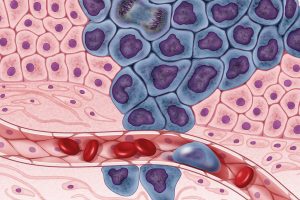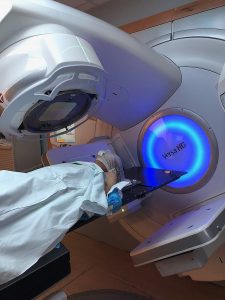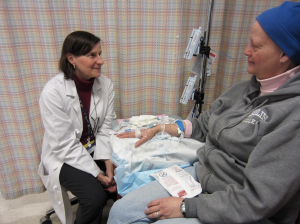21 Innovations in Cancer Technology
Emma Weeks
21.1 Introduction

“Cancer cells illustration” by Darryl Leja is in the Public Domain
Keywords
- cancer– a disease caused when some of the body’s cells divide and grow uncontrollably and spread into other tissues
- cancer cells– cells that grow and divide continuously, resulting in the formation of tumors or abnormal cells in the bloodstream
- carcinoma– a type of cancer of the epithelial tissue, which is the tissue underneath the skin
- cell division– the division of a cell that produces two genetically identical daughter cells
- ChemoID– personalized anticancer treatments
- chemotherapy– a form of cancer treatment through the use of drugs to stop or slow the growth of cancer cells
- computed tomography (CT)- a diagnostic imaging test procedure in which detailed images of the body are produced
- DNA– a long molecule that contains the instructions for developing, living, and reproducing in the form of a genetic code
- growth factors– proteins that stimulate the cell growth and division, tissue repair, and differentiation
- laparoscope– a thin, tub-like instrument with a light and lens that is used to examine organs and other internal structures
- lymphoma– a cancer of the lymph system, a part of the body’s immune system
- magnetic resonance imaging (MRI)- a diagnostic imaging test procedure in which computer generated radio waves and a magnetic field produce detailed images of the body
- methotrexate– a diagnostic imaging test procedure that uses a magnetic field and computer-generated waves to produce images of the body in detail
- oncologist– a doctor specialized in diagnosing and treating cancer
- radiation– the process of sending off energy in waves or particles that travels at the speed of light
- radiation therapy– a form of cancer treatment that shrinks tumors and kills cancer cells through the use of high doses of radiation
- robotic surgery– the use of robotics to perform the surgical removal of cancer in a precise, minimally invasive technique
- tumor– an abnormal mass of tissue made up of cancerous cells
- ultrasound– a procedure that uses sound waves to observe tissues and organs within the body
- x-ray– a diagnostic imaging test that uses electromagnetic waves to create pictures of tissues and organs within the body
Learning Objectives
By the end of this chapter, students should be able to:
- Distinguish between chemotherapy, radiotherapy, and surgical oncology
- Describe how technology has improved the effectiveness of cancer treatment
- Give insight to the historical background of treatments
- Compare and contrast the pros and cons of the technology
- Determine how cancer treatments may be improved in the future
There were estimated to be 15.5 million cancer survivors in the United States in 2016, and by 2026, that number is expected to increase to 20.3 million survivors because of innovations in treatment technology. Healthy human cells grow and multiply through a process called cell division, only forming new cells when others become damaged or grow old. However, cancer cells divide uncontrollably and spread to other tissues in the body. This uncontrollable cell division is a genetic disease known as cancer. The dividing cancer cells grow in the absence of growth factor signals and ignore other signals that tell them to stop dividing or to die. These cells may form tumors, which are lumps of tissue that can spread to other parts of the body to form new tumors.
Over decades, oncologists have worked to create effective forms of cancer treatment to fight against the disease. Some of the cancer treatments include chemotherapy through the use of anticancer drugs, radiation therapy (radiotherapy) through emitting high doses of radiation at the site of a tumor, and the surgical removal of tumors. Although these treatments have some side effects including nausea, pain, and hair loss, the overall results from the treatment are very rewarding. Continuously modifying and improving the technologies involved in these treatments, researchers have discovered the most efficient ways to incorporate technology in aiding in the fight against cancer while also limiting the side effects. In addition, future innovations appear promising, using computers and other technologies to increase precision and personalization of treatment. Innovations in cancer technologies in the form of chemotherapy, radiation therapy, and surgical oncology have changed the way the medical field has approached research, diagnosis, and treatment and has progressed against the disease.
21.2 Defining Cancer Technologies
Key Takeaway
21.2.1 Chemotherapy
Chemotherapy is one of the most well-known forms of cancer treatment. Through the use of anticancer drugs, chemotherapy works by slowing or stopping the growth of cancer cells, which divide quickly and uncontrollably. Chemotherapy can be used to treat cancer by lessening its chance of returning or by controlling its growth. This form of treatment can also ease cancer symptoms by shrinking tumors that cause pain and other issues in the body. Chemotherapy technology continues to develop; one of the new technologies is known as ChemoID. Using ChemoID, oncologists can effectively determine the best fitting chemotherapy drug to treat each particular patient’s cancer. This new technology works by retrieving a small sample of the patient’s tumor, which is then grown to form tumors and cancer stem cells. The doctors then test these cells with a variety of chemotherapy drugs, and the most effective medicine is determined. This allows the patient to be treated with the most effective chemotherapy drug, leading to faster and more dramatic results.
21.2.2 Radiation Therapy
Another common form of cancer treatment is radiation therapy. Radiation therapy can kill cancer cells and shrink tumors through the use of high doses of radiation. Radiation works by damaging cancer cells’ DNA, and once damaged beyond repair, the cells stop dividing or die. This form of therapy is not instant; it takes days or weeks of treatments to damage the DNA to the point where the cancerous cells die. After this point, the cancer cells continue to die for weeks or months after the treatment. Unlike chemotherapy, which exposes the entire body to anticancer drugs, radiation therapy is a local treatment. This allows the treatment to be aimed only where it is needed, therefore only damaging the cancer cells with minimal harm to nearby healthy cells.
The two main types of radiation therapy are external beam and internal, and the type of therapy one receives is based on many factors including the type of cancer, the size and location of the tumor, past medical history, whether the patient is treated with other cancer treatments, and other factors like age and general health. External beam radiation therapy uses a machine that aims radiation in the form of photons, protons, and electrons, at the site of cancer. Internal radiation therapy is a treatment in which a source of radiation, either solid or liquid, is put inside a patient’s body. Another relatively new form of radiation treatment is called Intensity Modulated Radiation Therapy (IMRT), which uses a computer-controlled linear accelerator platform to direct high doses of radiation in controlled, appropriate volumes to a patient’s tumor. Although the doses are very high, the IMRT technology minimizes damage to healthy tissues close to the tumor. This technology allows the doctors to effectively use high amounts of radiation to fight cancerous cells without inducing any harm on the patient.

“Radiation therapy for cancer” by Jake M Bradford is licensed under CC BY-SA 4.0
21.2.3 Surgical Oncology
The removal of cancer via surgery is a procedure in which trained medical doctors, called surgical oncologists, use tools and machinery to take out a tumor. This form of cancer treatment is one of the oldest, and it continues to become even more effective. There are many different ways of performing surgery including laparoscopic procedures, lasers, and robotics.
Laparoscopic surgery is a minimally invasive form of surgical treatment, and it involves a surgeon making cuts in the body and inserting a small camera, called a laparoscope. The camera allows the surgeon to see what she is doing by projecting images from inside the body onto a monitor, allowing for more precise cuts to remove the tumor and yielding a smaller recovery time for the patient. Laser treatment involves the use of an intense, narrow beam of light to destroy or remove cancerous cells. Because tumor cells absorb different wavelengths of light, they can be targeted by selecting a certain wavelength of the laser. With surgery, doctors can also use lasers to seal blood vessels during surgery to reduce bleeding, vessels after surgery to reduce swelling and the spread of cancer cells, and nerve endings to reduce pain. Robotic surgery was designed to make minimally invasive surgeries even more precise. This form of surgical treatment allows doctors to have more precision, control, and flexibility through the use of a robotic surgical system that includes mechanical arms with surgical instruments attached and a camera arm. The surgeon is able to control the arms through a console that provides a magnified, high-definition, 3D view of the surgical site. This procedure enhances precision, and allows the surgeon to perform delicate, complex procedures that would otherwise have been impossible with other methods.
21.3 History of Cancer Technology
Key Takeaway
21.3.1 History of chemotherapy
During World War II, soldiers exposed to mustard gas were found to have toxicity in their bone marrow and blood cells, so the US army began to study a number of chemicals similar to mustard gas to develop more effective war agents and protective measures for their own soldiers. While working on this chemical development, researchers found that a compound called nitrogen mustard worked against lymphoma, a cancer of the lymph nodes. From then on, oncology researchers began to research and discover similar, more effective agents that worked against cancer cells by damaging their DNA and ultimately killing them.
Chemotherapy, through the use of methotrexate, as a treatment for cancer was developed in 1953 by Roy Hertz and Min Chiu Li. This landmarked the first complete cure of a solid human tumor by using the drug methotrexate to treat a patient with carcinoma, a cancer of the reproductive tissue. Five years later, NCI researchers James Holland, Emil Frei, and Emil Freireich demonstrated that combination chemotherapy of multiple drugs can produce remissions and prolong survival in patients with leukemia. Since then, chemotherapy has been continually researched and innovated to become more effective and personalized for each patient. ChemoID is an example of a modern technology of chemotherapy that involves a doctor determining the most effective medicine to treat a patient with.
21.3.2 History of Radiation Therapy
In 1896, German professor Wilhem Roentgen presented the x-ray in his lecture entitled “Concerning a New Kind of Ray.” This brought worldwide excitement, and in no time, x-rays were being used for diagnosis, and radiation began to be used to treat cancer. Roentgen received the first Nobel Prize ever awarded in physics in 1901 for his discovery. In France, a breakthrough study found that continuous doses of radiation over several weeks improved a cancer patient’s condition. At the beginning of the 20th century, scientists found that radiation could both cause and cure cancer. Many early radiologists would test the strength of radiation on themselves, resulting in many of them to develop leukemia for regular exposure to radiation. Since then, researchers have learned more about precautions necessary when working with radiation, and the technology involving radiation therapy has continued to improve. The innovation of conformal radiation therapy, which uses computed tomography (CT) images and computers to map the location of cancer, and other forms of radiation therapy have made radiation more precise and less invasive in attacking healthy cells.
21.3.3 History of Surgical Oncology
Cancer treatment has been around for ages with surgery being one of the oldest forms. Ancient surgeons knew that once a tumor was surgically removed, it would eventually return. Galen, a 2nd century Greek physician, wrote about surgical cures for breast cancer if the tumor was removed early-on. From then on, cancer treatment developed very slowly and did not start significantly progressing until the 19th and 20th centuries. Three surgeons, Bilroth, Handley, and Halsted, are recognized for the great advances they made in the science of cancer surgery, having designed operations to remove entire tumors as well as lymph nodes in the region of the tumor. Even more progress was made at the end of the 20th century, when surgeons developed expertise in using new technologies to aid in surgery. Exploratory surgery for diagnosis of cancer was no longer needed, as physicians were able to utilize imaging tests, such as CT scans, ultrasounds, and magnetic resonance imaging (MRI), to find and diagnose cancer. Today, other technologies like laparoscopes and endoscopes, miniature video cameras, allow surgeons to look and work inside the body without making large incisions in the skin. Surgical technologies continue to develop today to make operations less invasive and to allow patients to have a smaller recovery time.

“Historical Photograph Operating Room Suite Surgical Procedure” by Roy Perry is in the Public Domain, CC0
21.4 Impacts on Society
Key Takeaway
21.4.1 Pros of the Technologies
Advances in chemotherapy, radiation therapy, and surgery have allowed cancer treatment to become more effective, personalized, and minimally invasive. Chemotherapy works to stop or slow cancer by distributing cancer patients drugs that damage a cancer cell’s DNA, lessening the chance that the cancer returns and easing cancer symptoms. A study performed by the Japanese Journal of Clinical Oncology found that using a personalized drug selection in chemotherapy improved the survival rate of breast cancer patients by 35-50% (Low and Nakamura 2019). Researchers continue to develop more technologies for personalizing chemotherapy drugs to find the most effective type for each individual patient. In addition, advances in radiation therapy have allowed treatment to become extremely localized, harming less of the healthy cells surrounding the cancerous tissue. The main advantages of radiotherapy are that it controls the growth of cancer, eases patients of symptoms and pain caused by a tumor, and quickly treats cancer in thirty minute treatments over weeks or months. Lastly, surgery through the use of lasers or laparoscopes have allowed surgeons to remove tumors precisely with high safety and a clean result. These technologies provide patients with shorter recovery times
21.4.2 Cons of the Technologies
Although these technologies have many advantages, they can also cause some detrimental side effects. The chemotherapy drugs distributed to patients travel throughout the body with the purpose of killing cancer cells; however, they can also affect normal, healthy cells that are fast growing. The healthy cells that are most likely to be affected by chemotherapy are hair follicles, blood-forming cells in the bone marrow, and cells in the reproductive system, digestive tract, and mouth. This can cause fatigue, hair loss, nausea, diarrhea, fertility problems, easy bruising and bleeding, and other side effects in patients treated with chemotherapy. Radiotherapy can also cause similar side effects including fatigue, nausea and vomiting, and diarrhea. In addition, surgery can have high risks including pain at the site of surgery, possible infection, damage to nearby tissue, and a slow recovery of other body functions. Although these cancer treatments come with side effects and certain risks, they can ease the effects of cancer or even result in the effective removal of cancer from the body.

“Chemo Nurse and Patient” by kbrookes is licensed under CC BY-NC-ND 2.0
21.5 Future Outlook
Key Takeaway
21.5.1 The Future of Cancer Treatment
The technology used to administer cancer treatment has changed a great deal and continues to become more effective. An example of new technology in cancer treatment is ChemoID. Through the use of ChemoID, oncologists can determine the most effective chemotherapy drug to treat individual patients by sampling a sample of a patient’s tumor. This sample is then grown into a bulk tumor and tested with a variety of chemotherapy drugs, and the medicine that kills the cancer cells most effectively is determined and used to treat the patient. This method allows the physician to avoid unnecessarily long and painful treatment, and the patient instead receives the treatment that would best treat their cancer while saving money on less effective drugs. When cancer treatment is personalized, a patient has a higher chance of fighting cancer and recovering.
New technology has also changed the way oncologists have approached the use of radiation therapy. Advances in radiotherapy have lessened the danger of damaging healthy cells surrounding cancer cells. Intensity Modulated Radiation Therapy (IMRT) uses computer-controlled linear accelerators, treatment machines used to deliver radiation to a cancer patient. This type of radiotherapy allows the linear accelerator to direct high doses of radiation to a tumor in appropriate volumes while minimizing damage to healthy tissue. This computer-controlled treatment uses higher doses of radiation to effectively fight cancer without causing harm to the health of the patient.
The future of cancer surgery involves the use of robotics. Surgeons can perform surgery by using robot arms connected to surgical instruments and other devices to remove tumors. Robotic surgery increases precision and control when operating on complex, delicate parts of the body. As computer and mechanical technology advances, researchers expect future systems to remove cancer quickly with less surgical side effects.

“Robot assisted surgery” by فاطمه درستی is licensed under CC BY-SA 4.0
Case Study: Living Life to the Fullest Despite Four Cancer Diagnosis
In September 2006, Christy was diagnosed with stage IV lung cancer which had spread to both of her lungs and her neck. She also had a tumor in her chest that was the size of a golf ball. Doctors told her that she had a two percent chance of living, and that most people with her diagnosis die within a year. Instead of sulking at the fact that she had a 98% chance of dying, she focused on that 2% chance of living. Christy stayed strong and was determined that cancer was not going to beat her. At this point, chemotherapy was her only option for treatment because the cancer was spreading. She went to chemo every other week for seventeen weeks, and with that treatment came fatigue, weight gain, and hair loss. Despite this, Christy still continued to fight and take advantage of her life like never before; she bought a motorcycle, rode in a hot air balloon, and traveled the world. After about a year and a half of chemo, she was finally cancer free for the first time. However, the cancer returned in 2013: a tumor the size of a walnut was found again in her chest. She got this tumor surgically removed and was once cancer free again. Unfortunately in 2014 and again in 2017 doctors found tumors lining the inside of her lungs, and Christy went through rounds 3 and 4 of treatment. She looks at this whole experience as sort of a blessing. Not the cancer, but the love and desire to live life to the fullest. She decides not to focus on the fact that she has cancer but on being happy and alive. Since she was first diagnosed, she has been able to provide hope and strength to other cancer patients, and she has been able to participate in clinical trials that will help save many lives in the future. The treatments she went through helped her to survive and celebrate being a 13-year IV lung cancer patient and defy all of the statistics that were against her favor.
Chapter Summary
Cancer is a genetic disease in which cells grow and divide uncontrollably in the absence of growth factors. These cancer cells may form tumors, which can spread cancer to other parts of the body. Oncologists and researchers have developed different forms of treatment for slowing or stopping the disease, and they continue to work to find ways to make the treatment even more effective. In this chapter, cancer treatments in the form of chemotherapy, radiotherapy, and surgery are discussed. Chemotherapy involves infusing cancer DNA-damaging drugs into patient’s bodies, and radiotherapy also damages cancer cells’ DNA by directing high doses of radiation at the sites of tumors. The surgical removal of tumors with the aid of technologies is also observed. In addition, the historic trends of these treatments are observed, and their impacts on society are analyzed. The pros of these treatments are that they work to fight cancer and show beneficial results; however, some cons to these treatments are the side effects. As technology continues to develop, these treatments will become even more precise in the future.
Review Questions
1. What common side effects accompany chemotherapy?
A) Scarring, bleeding, infection
B) Nausea, fatigue, hair loss
C) Blood clots, damage to organs, swelling
D) Increased appetite, heightened energy
2. What form of cancer treatment has been around the longest?
A) Robotic Surgery
B) Chemotherapy
C) Surgical removal of tumors
D) Radiation therapy
3. Which surgical technology does not require energy?
A) Lasers
B) Robotics
C) Laparoscopes
D) Scalpel
4. What technology did radiotherapy develop from?
A) Computerized tomography
B) Magnetic resonance imaging
C) X-rays
D) Ultrasound
Answers:
- B
- C
- D
- C
Food For Thought
- Why is personalized cancer treatment more effective than non-personalized treatment?
- How do computers increase precision in cancer treatment?
References
Editorial Staff. (2019, December 18). Christy’s story: Remaining positive through four cancer diagnoses. American Lung Association. Retrieved December 3, 2021, from https://www.lung.org/blog/remaining-positive-after-cancer.
Hirsch, F. R., Franklin, W. A., Gazdar, A. F., & Bunn, P. A. (2001, January 1). Early detection of lung cancer: Clinical perspectives of recent advances in biology and radiology. Clinical Cancer Research. Retrieved November 10, 2021, from https://clincancerres.aacrjournals.org/content/7/1/5.short.
History of cancer treatments: Radiation therapy. American Cancer Society. (n.d.). Retrieved November 18, 2021, from https://www.cancer.org/cancer/cancer-basics/history-of-cancer/cancer-treatment-radiation.html.
How radiation therapy is used to treat cancer. American Cancer Society. (n.d.). Retrieved November 18, 2021, from https://www.cancer.org/treatment/treatments-and-side-effects/treatment-types/radiation/basics.html.
Milestones in cancer research and Discovery. National Cancer Institute. (n.d.). Retrieved November 10, 2021, from https://www.cancer.gov/research/progress/250-years-milestones.
New Technology is making a difference in the fight against cancer. Cancer Treatment. (n.d.). Retrieved November 10, 2021, from https://www.pvhomed.com/new-technology-is-making-a-difference-in-the-fight-against-cancer/
Rochman, S. (2020, July 16). Robotic Surgery and cancer. Robotic Surgery and Cancer | Cancer Today. Retrieved November 18, 2021, from https://www.cancertodaymag.org/Pages/Summer2020/Robotic-Surgery-and-Cancer.aspx.
The Tech Revolutionizing Cancer Research and Care. National Cancer Institute. (n.d.). Retrieved November 10, 2021, from https://www.cancer.gov/news-events/nca50/stories/technologies-and-innovations.
Types of cancer treatment. National Cancer Institute. (n.d.). Retrieved November 10, 2021, from https://www.cancer.gov/about-cancer/treatment/types.
Wright, A. A., Cronin, A., Milne, D. E., Bookman, M. A., Burger, R. A., Cohn, D. E., Cristea, M. C., Griggs, J. J., Keating, N. L., Levenback, C. F., Mantia-Smaldone, G., Matulonis, U. A., Meyer, L. A., Niland, J. C., Weeks, J. C., & O’Malley, D. M. (2015, September 10). Use and effectiveness of intraperitoneal chemotherapy for treatment of ovarian cancer. Journal of clinical oncology : official journal of the American Society of Clinical Oncology. Retrieved November 10, 2021, from https://www.ncbi.nlm.nih.gov/pmc/articles/PMC4554746/
The division of a cell that produces two genetically identical daughter cells.
Cells that grow and divide continuously, resulting in the formation of tumors or abnormal cells in the bloodstream.
Proteins that stimulate the cell growth and division, tissue repair, and differentiation.
An abnormal mass of tissue made up of cancerous cells.
A doctor specialized in diagnosing and treating cancer.
A form of cancer treatment through the use of drugs to stop or slow the growth of cancer cells.
A form of cancer treatment that shrinks tumors and kills cancer cells through the use of high doses of radiation.
The process of sending off energy in waves or particles that travels at the speed of light.
Personalized anticancer treatments.
A long molecule that contains the instructions for developing, living, and reproducing in the form of a genetic code.
A thin, tub-like instrument with a light and lens that is used to examine organs and other internal structures.
The use of robotics to perform the surgical removal of cancer in a precise, minimally invasive technique.
A cancer of the lymph system, a part of the body’s immune system.
A diagnostic imaging test procedure that uses a magnetic field and computer-generated waves to produce images of the body in detail.
A type of cancer of the epithelial tissue, which is the tissue underneath the skin.
A diagnostic imaging test that uses electromagnetic waves to create pictures of tissues and organs within the body.
A diagnostic imaging test procedure in which detailed images of the body are produced.
A procedure that uses sound waves to observe tissues and organs within the body.
A diagnostic imaging test procedure in which computer generated radio waves and a magnetic field produce detailed images of the body.

